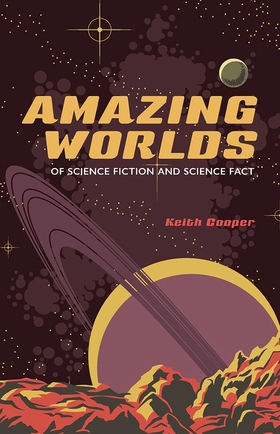Centauri Dreams
Imagining and Planning Interstellar Exploration
Hubble Looks at Voyager’s Future
Nothing built by humans has ever gotten as far from our planet as Voyager 1, which is now almost 21 billion kilometers from Earth. We’ve talked about the future of both Voyagers before in these pages — Voyager 1 passes within about 1.6 light years of the star Gliese 445 in some 40,000 years, its closest approach to a neighboring star. Voyager 2, which is now almost 17 billion kilometers out, closes to within 1.7 light years of Ross 248 in the same 40,000 years.
My case for doing what Carl Sagan once discussed, giving each Voyager a final kick with its remaining hydrazine, so that those closing distances could be reduced, can be found in Voyager to a Star. It would be a symbolic and philosophical act rather than a scientific one, as both Voyagers are losing their ability to transmit data and will be silent in about a decade. And nothing can reduce those huge timeframes, which means that any such symbolic statement would be made to the future, a way of saying we are learning to be a starfaring species.
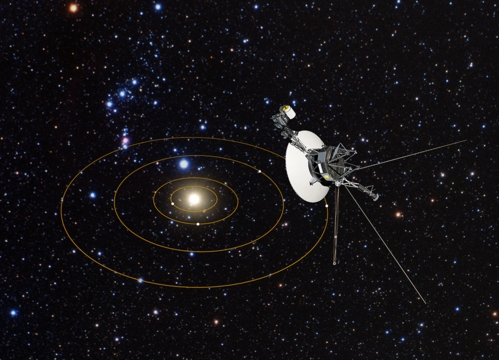
Image: In this artist’s conception, NASA’s Voyager 1 spacecraft has a bird’s-eye view of the solar system. The circles represent the orbits of the major outer planets: Jupiter, Saturn, Uranus, and Neptune. Launched in 1977, Voyager 1 visited the planets Jupiter and Saturn. The spacecraft is now 21 billion kilometers from Earth, making it the farthest and fastest-moving human-made object ever built. In fact, Voyager 1 is now zooming through interstellar space, the region between the stars that is filled with gas, dust, and material recycled from dying stars. Credit: NASA, ESA, and J. Zachary and S. Redfield (Wesleyan University); Artist’s Illustration Credit: NASA, ESA, and G. Bacon (STScI).
Meanwhile, we still have two viable spacecraft in the outer reaches of our Solar System, taking data on interstellar material, magnetic fields and cosmic ray hits and giving us a sense of what the local interstellar medium (LISM) is like. That’s crucial information, of course, for one day we hope to have not just a few but many spacecraft operating on the edge of interstellar space, and going beyond our system will require us to know the nature of the medium through which they move. On that score, the best book I know is Bruce Draine’s Physics of the Interstellar and Intergalactic Medium (Princeton, 2010). I enjoyed talking to Draine (Princeton University) at the latest Breakthrough Starshot sessions.
As you can imagine, learning more about the interstellar medium is a prerequisite if you’re thinking of pushing something up to 20 percent of lightspeed, as Breakthrough Starshot is, so the topic was a lively one at those meetings. At the recent American Astronomical Society meetings in Texas, we learned that astronomers have been using Hubble data to supplement what Voyager has been giving us, charting the hydrogen clouds and other elements of the LISM. Seth Redfield (Wesleyan University), who leads the study, offers this comment:
“This is a great opportunity to compare data from in situ measurements of the space environment by the Voyager spacecraft and telescopic measurements by Hubble. The Voyagers are sampling tiny regions as they plow through space at roughly 38,000 miles per hour [61,000 kph). But we have no idea if these small areas are typical or rare. The Hubble observations give us a broader view because the telescope is looking along a longer and wider path. So Hubble gives context to what each Voyager is passing through.”
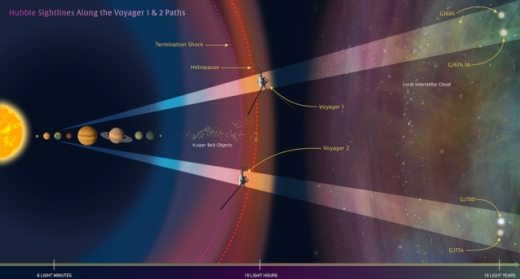
Image: In this illustration, NASA’s Hubble Space Telescope is looking along the paths of NASA’s Voyager 1 and 2 spacecraft as they journey through the solar system and into interstellar space. Hubble is gazing at two sight lines (the twin cone-shaped features) along each spacecraft’s path. The telescope’s goal is to help astronomers map interstellar structure along each spacecraft’s star-bound route. Each sight line stretches several light-years to nearby stars. Credit: NASA, ESA, and Z. Levy (STScI).
The Hubble work makes it clear that in two thousand years or so, Voyager 2 will move out of the interstellar cloud that surrounds the Solar System before moving into another cloud, in which it will remain for as much as 90,000 years. The astronomers find slight variations in the abundances of the chemical elements in these clouds, which could chart a history involving different paths to formation. We do know that as the solar wind pushes against the interstellar medium, the heliosphere can be compressed, only to expand again when the Sun moves through lower-density matter. For more, see this Hubblesite news release.
We still haven’t built the next generation LISM explorer, one crafted from the outset as an interstellar data gatherer. As much as the Voyagers continue to give us, we have to remember that they were designed as planetary probes, their survival to this point being an amazing and unexpected gift, but one that has to be adapted to the medium through which the spacecraft move. A spacecraft fine-tuned for exploration beyond the heliopause is a goal that continues to see its share of study (more on this soon), but when it will fly remains an open question.

Upgraded Search for Alpha Centauri Planets
Breakthrough Starshot, the research and engineering effort to lay the groundwork for the launch of nanocraft to Alpha Centauri within a generation, is now investing in an attempt to learn a great deal more about possible planets around these stars. We already know about Proxima b, the highly interesting world orbiting the red dwarf in the system, but we also have a K- and G-class star here, either of which might have planets of its own.
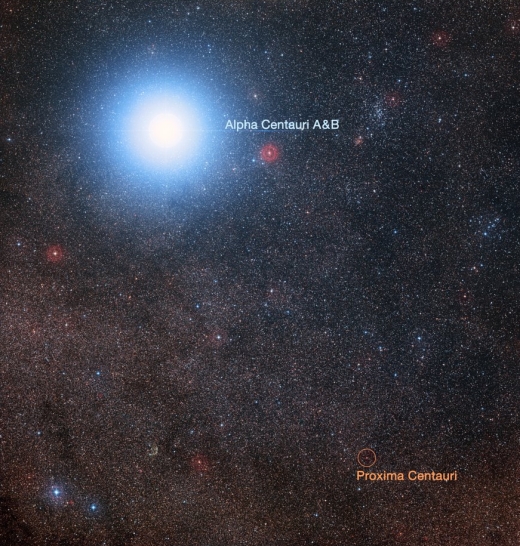
Image: The Alpha Centauri system. The combined light of Centauri A (G-class) and Centauri B (K-class) appears here as a single overwhelmingly bright ‘star.’ Proxima Centauri can be seen circled at bottom right. Credit: European Southern Observatory.
To learn more, Breakthrough Initiatives is working with the European Southern Observatory on modifications to the VISIR instrument (VLT Imager and Spectrometer for mid-Infrared) mounted at ESO’s Very Large Telescope (VLT). Observing in the infrared has advantages for detecting an exoplanet because the contrast between the light of the star and the light of the planet is diminished at these wavelengths, although the star is still millions of times brighter.
To surmount the problem, VISIR will be fitted out for adaptive optics. In addition, Kampf Telescope Optics of Munich will deliver a wavefront sensor and calibration device, while the University of Liège (Belgium) and Uppsala University (Sweden) will jointly develop a coronagraph that will mask the light of the star enough to reveal terrestrial planets.

Image: Paranal at sunset. This panoramic photograph captures the ESO Very Large Telescope (VLT) as twilight comes to Cerro Paranal. The enclosures of the VLT stand out in the picture as the telescopes in them are readied for the night. The VLT is the world’s most powerful advanced optical telescope, consisting of four Unit Telescopes with primary mirrors 8.2 metres in diameter and four movable 1.8-metre Auxiliary Telescopes (ATs), which can be seen in the left corner of the image. Credit: ESO.
According to the agreement signed by Breakthrough Initiatives executive director Pete Worden and European Southern Observatory director general Tim de Zeeuw, Breakthrough Initiatives will pay for a large part of the technology and development costs for the VISIR modifications. Meanwhile, the ESO will provide the necessary telescope time for a search program that will be conducted in 2019. The VISIR work, according to this ESO news release, should provide a proof of concept for the METIS instrument (Mid-infrared E-ELT Imager and Spectrograph), the third instrument on the upcoming European Extremely Large Telescope.

Garnet World: Stellar Composition & Planetary Outcomes
What effect does the composition of a star have on the planets that form around it? Enough of one that we need to take it into account as we assess exoplanets in terms of astrobiology. So says a study that was presented at the American Astronomical Society meeting in Texas last week, looking at ninety specific stars identified by Kepler as having evidence of rocky planets.
We know about the composition of these stars because they are part of the 200,000 star dataset compiled by APOGEE, the Apache Point Observatory Galactic Evolution Experiment spectrograph mounted on the 2.5m Sloan Foundation telescope in New Mexico. APOGEE allows us to examine the spectra of stellar atmospheres to identify their elements.
Modeling the formation of planets around these stars shows us the implications for astrobiology. Johana Teske (Carnegie Observatories) explains:
“Our study combines new observations of stars with new models of planetary interiors. We want to better understand the diversity of small, rocky exoplanet composition and structure — how likely are they to have plate tectonics or magnetic fields?”
At the AAS meeting, Teske described how the team of astronomers and geoscientists she is working with focused on Kepler 102 and Kepler 407, the former a star slightly less luminous than the Sun hosting five known planets, the latter hosting two planets orbiting a star of roughly the Sun’s mass. The APOGEE data show that in terms of chemical composition, Kepler 102 is similar to the Sun, while Kepler 407 is much richer in silicon.
Geophysicist Cayman Unterborn (Arizona State) ran computer simulations of planet formation incorporating the APOGEE data. The result:
“We took the star compositions found by APOGEE and modeled how the elements condensed into planets in our models. We found that the planet around Kepler 407, which we called ‘Janet,” would likely be rich in the mineral garnet. The planet around Kepler 102, which we called ‘Olive,’ is probably rich in olivine, like Earth.”
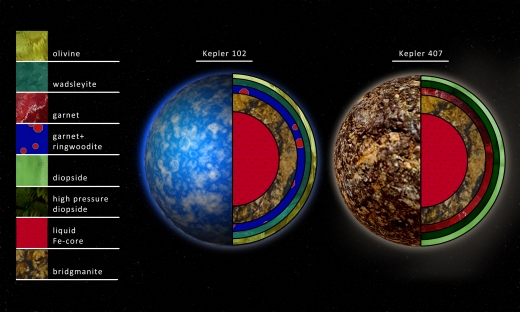
Image: The picture shows what minerals are likely to occur at several different depths. Kepler 102 is Earth-like, dominated by olivine minerals, whereas Kepler 407 is dominated by garnet, so less likely to have plate tectonics. Credit: Robin Dienel, Carnegie DTM.
In Unterborn’s view, the difference is significant because garnet, a far stiffer mineral than olivine, flows more slowly, implying a garnet planet would be unlikely to have long-term plate tectonics. Like the Earth, the planet around Kepler 102 could sustain tectonics, which are thought to be essential for life because atmospheric recycling through geological processes like volcanoes and ocean ridge formation regulates the atmosphere’s composition. Without such geological processes, life would not necessarily have the chance to evolve.
Centauri Dreams‘ take: The interplay of the two datasets — APOGEE and Kepler — is deeply productive, but we’re only at the beginning of the analysis. APOGEE’s 200,000 stars include others known to host small planets, so similar methods can now be put to work on the mineral content of these worlds. Those most Earth-like in their mineral content would rank higher on our list for further astrobiological study, helping us refine our targets for future observation.

NASA Selects Two Asteroid Missions
Among the five finalists for NASA’s Discovery program, I had become attached to the Near Earth Object Camera (NEOCam), whose purpose was to expand our catalog greatly, with the potential, according to mission backers, of finding ten times more NEOs than we’ve found to date. We’ll see if NEOCam has a future (I’ve just learned that it has been given extended funding for an additional year by NASA), but for now NASA has announced two other Discovery-class missions, both of which have objectives among the asteroids.
Lucy, scheduled for a launch in the fall of 2021, is to be a robotic mission with the goal of exploring six of the Jupiter Trojan asteroids. The Trojans share Jupiter’s orbit while moving swarm-like around the planet’s L4 and L5 Lagrangian points. Over 6000 Jupiter Trojans are now known, but the population is thought to be vast, with as many as 1 million Trojans larger than 1 kilometer in diameter. As to their origin, there is much to learn. They may be captured asteroids or comets, or as this short NASA video explains, even Kuiper Belt Objects.
From the standpoint of Solar System evolution, the Trojans make for interesting science. They’re relics of the primordial material of the outer system, and I see that principal investigator Harold F. Levison cites the mission’s name in connection with another Lucy, the fossil fragments that have been so significant in our understanding of human development. We’ll see if this Lucy gets as much public attention as its namesake, which acquired its name from the Beatles song ‘Lucy in the Sky with Diamonds,’ played at the recovery site in Ethiopia. Breaking out the Sgt. Pepper album on this Lucy’s arrival at its first target seems a natural.
There are connections between the Lucy effort and the highly successful New Horizons mission, in the form of later versions of the familiar RALPH and LORRI science instruments, and evidently several members of the Lucy mission team are connected with New Horizons as well. Lucy also benefits from the contributions of several members of the OSIRIS-REx team, the latter a robotic spacecraft now on its way to rendezvous with asteroid Bennu.
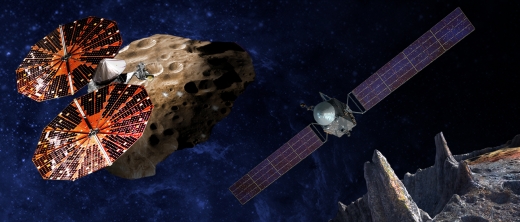
Image: (Left) An artist’s conception of the Lucy spacecraft flying by the Trojan Eurybates – one of the six diverse and scientifically important Trojans to be studied. Trojans are fossils of planet formation and so will supply important clues to the earliest history of the solar system. (Right) Psyche, the first mission to the metal world 16 Psyche will map features, structure, composition, and magnetic field, and examine a landscape unlike anything explored before. Psyche will teach us about the hidden cores of the Earth, Mars, Mercury and Venus.
Credit: SwRI and SSL/Peter Rubin.
The other mission is Psyche, dedicated to a single asteroid of that name that appears to be the survivor of an early collision with another object that violently disrupted a protoplanet. About 210 kilometers in diameter, 16 Psyche is thought to be composed mostly of metallic iron and nickel, a composition similar to the Earth’s core. We seem to be looking at what would have become the core of a Mars-sized planet, now without its outer rocky layers. Thomas H. Prettyman, a co-investigator on the Psyche mission, explains:
“Psyche is thought to be the exposed core of a planetary embryo – perhaps like Vesta – that initially melted and later cooled to form a central metallic core, silicate mantle, and basaltic crust. The outer layers may have been removed in a violent collision, leaving the core exposed. Psyche will provide a close-up look at a planetary core, providing new insights into the evolution and inner workings of terrestrial planets.”
The robotic Psyche mission will launch in the fall of 2023, with arrival at 16 Psyche in 2030 after two gravity assists, one from an Earth flyby, the second from a flyby of Mars. Both missions have this is common: They target the development of the early Solar System, one by observing the remnants of formation among the Jupiter Trojans, the other by seeing the interior of what might have become a planet. Let’s hope for the kind of success for both that we saw in earlier Discovery missions like MESSENGER and Dawn. OSIRIS-REx, meanwhile, is on course for a 2018 rendezvous with asteroid Bennu, with sample return to follow.

Pinpointing a Fast Radio Burst
Fast Radio Bursts (FRBs) are problematic. Since their discovery about a decade ago, the question has been their place of origin. These transient pulses last no more than milliseconds, yet they emit enormous energies, and we’ve had only the sketchiest idea where they came from. Now we learn, from an announcement at the 229th meeting of the American Astronomical Society in Grapevine, Texas, that a repeating source of FRBs has been spotted. That makes tracing the burst back to its source and characterizing it an ongoing proposition.
“We now know that this particular burst comes from a dwarf galaxy more than three billion light-years from Earth,” says Shami Chatterjee, of Cornell University. “That simple fact is a huge advance in our understanding of these events.” Papers on the work are being presented in Nature as well as Astrophysical Journal Letters.
Research behind the investigation of FRB 121102 has been mounted by an international team of astronomers, representing a spread of instruments that is important because a single-dish detection cannot target the object’s location. Because it repeats, this burst allows telescopes separated by large distances to home in on it and investigate it at various wavelengths.
The FRB was discovered at Arecibo, but observations with the Very Large Array in New Mexico have found a total of nine radio bursts from this source. Observations using the 8-meter Gemini North instrument on Mauna Kea have been able to pinpoint the host galaxy, which comes in at a redshift value that puts its distance at over 3 billion light years. Between Arecibo, the VLA and the European VLBI Network (EVN), astronomers have now been able to determine the position of the burst to a fraction of an arcsecond, more than 200 times as accurate as previous measurements. An ongoing and persistent source of weak radio emission is also found in the same region.
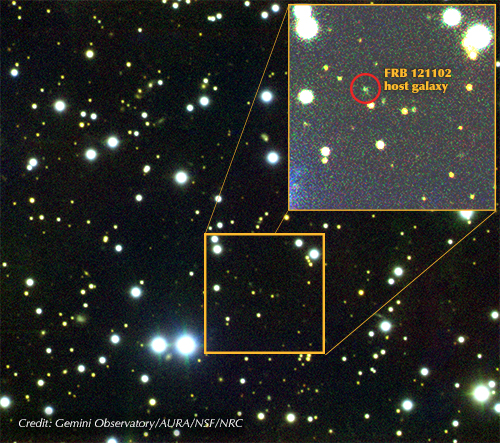
Image: Gemini composite image of the field around FRB 121102 (indicated). The dwarf host galaxy was imaged, and spectroscopy performed, using the Gemini Multi-Object Spectrograph (GMOS) on the Gemini North telescope on Maunakea in Hawai’i. Data were obtained on October 24-25 and November 2, 2016. Credit: Gemini Observatory/AURA/NSF/NRC.
Remember that until this event, only the Parkes Radio Telescope in Australia had detected FRBs, and only a small number at that. Now we are talking not only about locating the source in visible light but associating it with a radio source. Benito Marcote works at JIVE (Joint Institute for VLBI in Europe), which includes a 100-meter radio telescope in Effelsberg, Germany.
“With a bit of luck,” says Marcote, “we were able to detect bursts from FRB 121102 with the EVN and now we know that the origin of the bursts is right on top of the persistent radio source… We think that the bursts and the continuous source are likely to be either the same object or that they are somehow physically associated with each other.”
This FRB, at least, is now known incontrovertibly to have an origin far outside our own galaxy, although the galaxy itself is a surprise. It’s a small dwarf galaxy younger than ours, one that may be able to produce more massive stars than we see in the Milky Way. One possibility is that FRB 121102 is from the collapsed remnant of such a star. Shriharsh Tendulkar (McGill University) is lead author of one of the papers studying the event.
“The host galaxy for this FRB appears to be a very humble and unassuming dwarf galaxy, which is less than 1% of the mass or our Milky Way galaxy. That’s surprising. One would generally expect most FRBs to come from large galaxies which have the largest numbers of stars and neutron stars — remnants of massive stars. This dwarf galaxy has fewer stars, but is forming stars at a high rate, which may suggest that FRBs are linked to young neutron stars. There are also two other classes of extreme events — long duration gamma-ray bursts and superluminous supernovae — that frequently occur in dwarf galaxies, as well. This discovery may hint at links between FRBs and those two kinds of events.”
A burst originating from the region near a massive black hole in the galaxy’s core — an active galactic nucleus emitting jets of material — is a candidate for FRB 121102. And as data continue to accumulate, any periodicity found in future observations may point to the involvement of a rotating neutron star. Further entangling the story is a key question: Can we assume that all FRBs we’ve thus far detected have the same origins, or are we actually detecting more than one kind of cosmic event? Given that FRB 121102 is the only one of 18 known FRBs that repeats, we may be looking at different physical processes at work.
The papers are Chatterjee et al., “A direct localization of a fast radio burst and its host,” Nature 541 (5 January 2017), 58-61 (abstract); Tendulkar et al., “The Host Galaxy and Redshift of the Repeating Fast Radio Burst FRB 121102,” Astrophysical Journal Letters Vol. 834, No. 2 (4 January 2017) (abstract); B. Marcote et al., “The Repeating Fast Radio Burst FRB 121102 as Seen on Milliarcsecond Angular Scales,” Astrophysical Journal Letters Vol. 834, No. 2 (4 January 2017)(abstract).

Hitchhiker to the Outer System?
Years ago at the Aosta conference on interstellar studies, Greg Matloff told attendees about an interesting way to travel the Solar System. If the goal is to get to Mars, for example, it turns out that there are two objects — 1999YR14 and 2007EE26 — that pass close to both Earth and Mars, each with transit time of about a year. Let me quote from Greg’s paper:
Since orbital characteristics are known for a few thousand NEOs, it is reasonable to assume that about 0.1% of the total NEO population could be applied for Earth-Mars or Mars-Earth transfers during the time period 2020-2100. Because a few hundred thousand NEOs must exist that are greater in dimension than 10m, hundreds of small NEOs must travel near-Hohmann trajectories between Earth and Mars or Mars and Earth. It seems likely that a concerted search will find one or more candidate NEOs for shielding application during any opposition of the two planets.
The notion is provocative. Could we somehow hitch a ride on one of these objects, taking advantage of its capabilities as a radiation shield by digging into its surface and exploiting its resources along the way? And maybe we can look further than Mars. In 2014, a NEO called 2000WO148 swings by the Earth enroute to the main belt asteroid Vesta in 2043. The question becomes, are there other NEOs on interesting trajectories that might be of use in our explorations?
I was reminded of the NEO hitchhike idea this morning while reading about another interesting object. NEOWISE detected 2016 WF9 in late November of 2016. Here we have a true sightseer. 2016 WF9 approaches the orbit of Jupiter at its furthest point from the Sun, and then, over just under five years, swings inward, coming in past the main asteroid belt and the orbit of Mars to move just inside the orbit of the Earth before heading back out.
We get closest approach to Earth’s orbit on February 25th of this year, although at 51 million kilometers, this object hardly poses a danger to our planet, nor will it in the foreseeable future. Whether 2016 WF9 is an asteroid or a comet is not known. What we know is that it is between 0.5 and 1 kilometer across, and has low reflectivity, as do many dark objects in the main asteroid belt. Although in a comet-like orbit, 2016 WF9 lacks the dust and gas we normally associate with a comet. James ‘Gerbs’ Bauer (JPL) is deputy chief investigator for NEOWISE:
“2016 WF9 could have cometary origins. This object illustrates that the boundary between asteroids and comets is a blurry one; perhaps over time this object has lost the majority of the volatiles that linger on or just under its surface.”
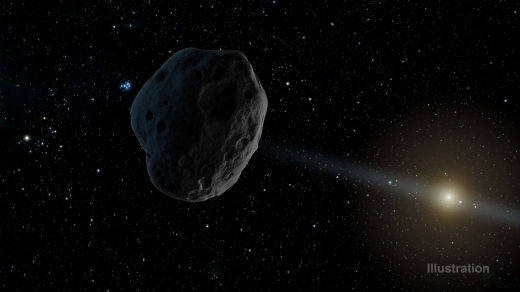
Image: An artist’s rendition of 2016 WF9 as it passes Jupiter’s orbit inbound toward the sun. Credit: NASA/JPL-Caltech.
Another object recently spotted by NEOWISE is indeed thought to be a comet, releasing dust as it nears the Sun. In the first week of the new year, C/2016 U1 NEOWISE will be in the southeastern sky shortly before dawn as seen from the northern hemisphere, reaching perihelion on January 14 inside the orbit of Mercury. Although it’s impossible to say for sure, it may become bright enough to be visible in binoculars, according to this JPL news release.
Since NEOWISE was reactivated in December of 2013, it has discovered either 9 or 10 comets, depending on what 2016 WF9 turns out to be. It 2016 WF9 is found to be an asteroid, then it would be the 100th discovered since reactivation. The original mission, the asteroid and comet-hunting part of the Wide-Field Infrared Survey Explorer (WISE) mission, discovered 34,000 asteroids. 31 of its discoveries pass within 20 lunar distances, and 19 are thought to be more than 140 meters in size, but reflect less than 10 percent of incident sunlight. They are objects as dark as new asphalt, absorbing most visible light but re-emitting energy at infrared wavelengths that the NEOWISE detectors can readily study.
For those interested in digging into these matters further, the NEOWISE data release, with access instructions and supporting documentation, is here. And on the fictional side, Kim Stanley Robinson’s novel 2312 looks at terraformed asteroids in terms of both habitats and intra-system transportation in an evolving space infrastructure.

